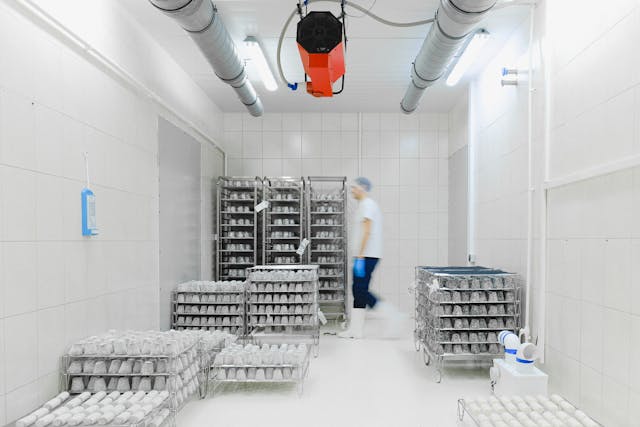Cold Storage Maintenance Guide (2025): Best Practices, Checklists & Common Issues

Introduction
What if your operators could spot issues before a single product is spoiled? Cold storage facilities play a silent yet essential role in keeping perishable goods—like fresh produce, vaccines, or dairy—safe and viable. But these systems are only as reliable as the maintenance that backs them.
Whether you’re managing a refrigerated warehouse or overseeing pharmaceutical storage, this guide gives you actionable, real-world strategies for keeping things cool, compliant, and cost-effective. We’ve compiled insights from the field and real operator stories to help you prevent downtime and maintain peace of mind.
What Is Cold Storage Maintenance?
Think of cold storage maintenance as the daily ritual that keeps your facility running at its best. It includes:
- Refrigeration system care
- Monitoring temperature sensors
- Inspecting door seals and insulation
- Ensuring backup systems are in place
- Keeping structural elements in check
Regular maintenance isn’t just technical—it’s smart risk management. It prevents breakdowns, saves on energy, and keeps you compliant with industry standards.
Quick Takeaway: Stay consistent with maintenance and avoid surprises later.
Why Cold Storage Maintenance Matters
Let’s break it down:
- Prevent Product Loss: One bad temperature spike can ruin thousands of dollars worth of goods.
- Stay Compliant: Regulations like HACCP or ISO 22000 aren’t suggestions—they’re requirements.
- Improve Efficiency: Clean, well-tuned systems use less power.
- Ensure Safety: Ice buildup isn’t just annoying—it’s a real slip hazard.
From the Field:
“We once lost an entire batch of seafood due to a faulty seal no one noticed. That mistake taught us to never skip the daily checks again.” — Plant Supervisor, Seafood Distributor
Quick Takeaway: A small oversight can snowball into a massive loss.
Cold Storage Maintenance Checklist
Want to see how maintenance is documented in regulated environments? Here’s a real-world example: Cold Storage Maintenance and Monitoring SOP (PDF) from Swansea University. While it’s designed for handling human tissue, many of its practices are relevant for general cold storage facilities.
Daily Maintenance
- ✅ Log temperatures and humidity
- ✅ Check door seals for wear
- ✅ Listen for unusual sounds from units
- ✅ Confirm doors close completely
Weekly Maintenance
- 🧹 Clean evaporator coils
- 🎯 Check sensor accuracy
- 💧 Inspect drains for clogs
Monthly Maintenance
- 🌀 Clean condenser fans
- ❄️ Check refrigerant levels
- 💡 Test emergency lighting
Quarterly Maintenance
- 🚨 Test alarms and monitoring
- 🧱 Inspect walls and flooring
- 🌬️ Conduct airflow checks
Annual Maintenance
- 🔧 Full professional inspection
- 🔍 Use thermal imaging for leaks
- 📚 Review SOPs and logs
Quick Takeaway: Routine = reliability.
Preventive vs. Reactive Maintenance
Preventive Maintenance means fixing problems before they exist. Schedule it, track it, and make it part of your workflow:
- Fewer emergencies
- Longer equipment life
- Smoother audits
Reactive Maintenance means waiting until something breaks. The cost?
- Emergency service fees
- Spoiled products
- Angry customers
Real Story:
“We used to run on a ‘fix-it-when-it-breaks’ model. Switching to preventive maintenance saved us over $20K a year—not to mention our reputation.” — Operations Head, Regional Food Distributor
Quick Takeaway: Preventive = proactive. Reactive = regret.
Common Cold Storage Maintenance Issues
- Ice Buildup – Often from warm air entering due to poor seals
- Leaking Refrigerant – Causes inconsistent temps and higher bills
- Sensor Failures – Bad readings = bad decisions
- Power Outages – No backup = disaster
- Structural Damage – Insulation gaps mean heat gets in fast
Quick Takeaway: Look for small signs before they become big problems.
Cold Storage: Food vs. Pharma
Both need cold storage—but their needs are different:
Food Storage
- Must meet food safety standards (e.g., HACCP)
- Focuses on cleanliness, airflow, pest control
Pharma Storage
- Requires precise control (e.g., 2°C to 8°C)
- Needs audit-ready documentation
- Often includes real-time monitoring and alerts
Quick Takeaway: Know your industry’s standards and build your checks around them.
Energy Efficiency Tips for Cold Storage
Cutting energy use doesn’t mean cutting performance:
- 💡 Switch to LED lighting with motion sensors
- 🧼 Regularly clean and maintain seals
- ⚙️ Upgrade to energy-efficient compressors
- 📲 Install remote monitoring tools
- 📦 Optimize product placement for airflow
Quick Takeaway: Efficiency = lower bills + longer equipment life.
FAQ: Cold Storage Maintenance
How often should cold storage units be inspected?
Daily for basics, weekly and monthly for deeper checks, and yearly by professionals.
What temperature should a cold storage facility maintain?
It depends on what’s stored. Frozen foods: ~-18°C. Pharma: 2°C–8°C.
What are signs of a failing system?
Ice buildup, inconsistent readings, and strange noises are early warnings.
Is one checklist enough for all facilities?
Nope. Customize based on product type, regulation, and facility size.
How can I cut energy costs?
Seal doors, monitor usage, and consider upgrading your systems.
Conclusion
Cold storage maintenance doesn’t have to be complicated—but it has to be consistent. And more importantly, it should be proactive, not reactive.
The difference between a smoothly running facility and a costly shutdown often comes down to a checklist, a trained team, and a few minutes of daily diligence.
From the Operator’s Chair:
“Honestly, the checklist isn’t hard. It’s the habit of doing it that matters. Once you make it part of the shift, it just becomes second nature.” — Cold Room Operator, Beverage Supplier
Want to implement proactive cold storage maintenance?
